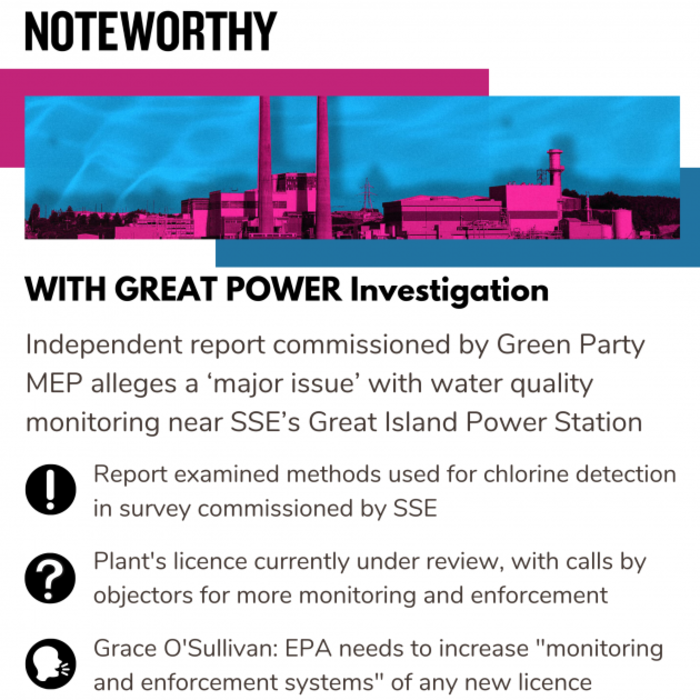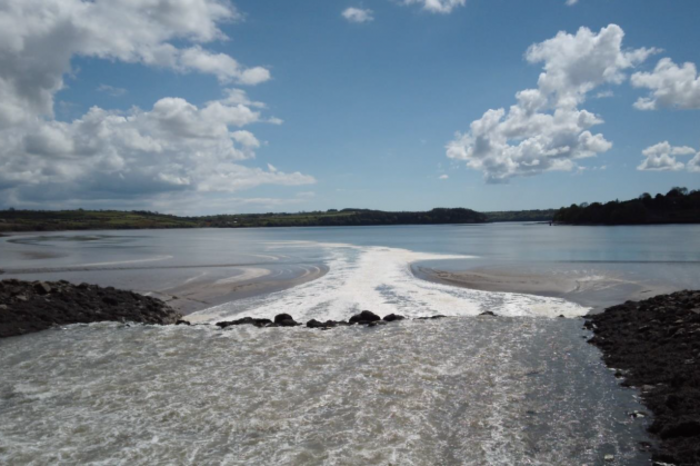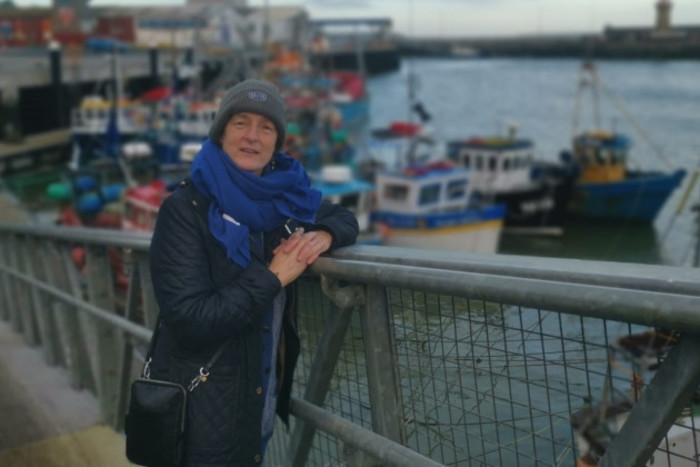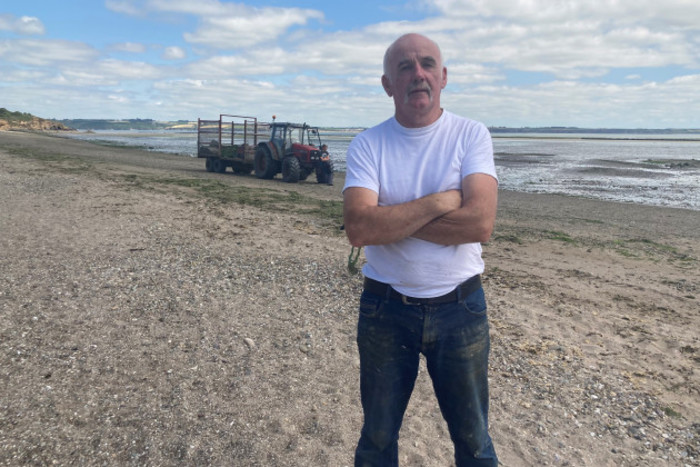Concerns over data submitted by Wexford power plant to EPA
Independent report alleges a ‘major issue’ with water quality monitoring near SSE’s Great Island Power Station.

—
THE BARROW ESTUARY between Waterford and Wexford has a rich oral history with tales of young fishermen forcibly enlisted during Napoleonic wartimes to salmon wars between rival fishing communities in the late 1800s.
Though these particular conflicts are long past, the estuary remains the focus of many locals, with growing concerns over potential pollution. Some of this attention is coming on SSE’s Great Island Power Station at the endpoint of the Three Sisters – the Barrow, Nore and Suir.
Environmental campaigners are alleging issues with monitoring of the station by the Environmental Protection Agency (EPA), citing an independent report, seen by Noteworthy.
Green Party MEP Grace O’Sullivan commissioned the report after contacting the EPA last year out of concern over water quality issues in the region, alleging that monitoring of the impact from certain bleaching chemicals by SSE risked being “neither accurate, nor representative of the water quality throughout the year” in the estuary.
This report – produced last year – examined a survey of the estuary conducted on behalf of SSE that was submitted to the EPA as part of the power plant’s ongoing licence review with a decision expected in November. It contended there are insufficient measurements of some chemicals due to how the survey was conducted.
O’Sullivan said she was concerned about the accuracy and timing of monitoring as part of the station’s licence review submission. She told Noteworthy that the EPA needs to “greatly increase the monitoring and enforcement systems accompanying any new licence”.
A spokesperson for SSE said that “as responsible operators, we take our environmental responsibilities seriously and work closely with the EPA to ensure continued compliance with the terms of our IPCC licence which covers all aspects of environmental management”.
With a licence up for review, focus has come in on how the SSE operates in the estuary and the EPA monitors activity there. For our WITH GREAT POWER investigation, Noteworthy found:
- Independent report alleges there was a “major” issue in the methods used as part of power plant’s EPA licence review for detecting elevated chlorine in the estuary
- A national environmental NGO is calling for an oral hearing and the EPA told Noteworthy that it is considering this request
- Use of a bleaching chemical in the estuary was almost 1,300 tonnes higher annually than described in the power plant’s licence application, with this error declared to the EPA by SSE in 2020
This investigation was funded in its entirety by the Noteworthy general fund which you can support here>>
—
Earlier complaints
 Great Island Power Plant in Co Wexford
Great Island Power Plant in Co Wexford
Located seven miles downriver from Waterford, and next to several designated areas of conservation, the station was built in the late 1960s as a heavy fuel oil station.
It was originally operated by the ESB, but is now a gas-fired power plant run by SSE Generation Ireland, a subsidiary of multinational energy company SSE. The station is currently not operating due to maintenance.
Chlorine – in the form of sodium hypochlorite – is added to the cooling water taken into the plant if it exceeds a certain temperature to prevent unwanted growths in internal pipes. The station’s licence conditions stipulate that this cooling water must be obtained from, and discharged to, the Barrow estuary.
This is not the first time that potential issues were raised, with the EPA previously receiving reports in 2016 and 2019 of shellfish dieback and other marine life health issues. These reports alleged that the discharge of chlorinated cooling water from Great Island was a contributing factor.
The EPA investigated these allegations and “found no evidence that SSE’s discharge” was having such an effect on shellfish and fish mortality. The agency said that the company was compliant with chlorine limits and that the station was “not the only potential pressure on water quality in the Waterford Estuary”. An EPA webpage dedicated to this issue states:
“Currently there is limited information on the nature and extent of shellfish dieback in Waterford Estuary or the reasons for such mortality. There is, consequently, insufficient evidence to conclude which individual pressures, if any, are contributing to the impacts on marine life in the estuary.”
 Foam on the estuary during an EPA site visit in May 2022
Foam on the estuary during an EPA site visit in May 2022
In addition to these reports, the EPA also received a number of complaints in recent years in relation to the station’s operation.
Last year, 13 of 15 complaints were relating to foam leaving the site. The foam was linked to the discharge from the station, although the EPA does not consider it toxic. The agency said it will maintain close surveillance of the station’s “preventative actions” for what it described as the “foaming problem”.
The EPA stated it “has found no evidence” that SSE is the “cause of poor water quality (other than foaming)” in the estuary.
Licence under review
The power plant’s licence is now being reviewed following the EPA’s refusal to allow SSE to amend its current licence. It had applied to discharge at two points, previously thought to be no longer in use since 2015.

In the same 2020 amendment request, the company identified an error in its licence review application for the use of sodium hypochlorite. It submitted that five tonnes per year would be used, when in fact annual usage is up to 1,300 tonnes.
Due to the EPA’s stance, SSE had to apply for a licence review to continue its operation which it did later that year.
In its proposed determination for the licence – issued earlier this year – the EPA said it considers that the station’s activity “will not adversely affect the integrity” of the estuary, once the company abides by a number of conditions it will impose when granting the licence.
This involves the maintenance and implementation of an Environmental Management System within six months.
Among other elements, this must include “an evaluation of practical options” for the “reduction of chlorine emissions” and the use of alternatives for maintaining the cooling water system.
‘Sufficient measurements’ of chemicals
As part of its licence review, SSE submitted a chlorine survey conducted by an environmental consultancy firm. The conditions of this survey included that “sufficient measurements” should be made to capture the variability of chlorine concentrations.
According to the EPA, measurements of chlorine should – at a minimum – be made over a period of at least two days, covering a range of tidal conditions and locations within the estuary. They should also include the surface and bottom layers of the water column, as well as an assessment of any potential impacts on water quality, marine organisms and sediments.
The report commissioned by Grace O’Sullivan’s office analysed the Barrow Estuary Chlorine Sampling Survey submitted by SSE to the EPA.
In the expert report produced for O’Sullivan, it was found that “while the field survey did take place over two days… it does not appear that sufficient measurements of chloride and chlorine were taken” to capture the variability of their concentrations.
 Green Party MEP Grace O’Sullivan needs to increase monitoring in the new power plant licence
Green Party MEP Grace O’Sullivan needs to increase monitoring in the new power plant licence
A highly qualified marine science researcher – with a doctorate in environmental science – who has experience in the marine sector and academia wrote the report. They noted that it can be difficult to get a proper hold on the concentration or volume of chemicals as the estuary is a dynamic body of water affected by changing tides and other factors.
The report added that it “appears that all chemical samples were collected on the same date” during a monthly spring tide when contamination “was less likely to be detectable” due to “increased tidal mixing”.
‘No way of connecting’ sampling data
The report concluded this could “seriously undermine the reliability” of the study submitted as part of the licence review. It added that a “lack of clarity” regarding the sampling regime meant it was “not possible” to assess whether more thorough analysis of the data could identify and characterise any signal of contamination from the SSE station.
The independent report also recommended that “an assessment of the fate of free chlorine as it breaks down in the environment” should be provided in the licence application. This should include the type and concentrations of by-products likely to arise, the report said, as well as the potential interaction of these by-products with sediments and organic matter.
O’Sullivan submitted the main findings of this report to the EPA last September as part of the power plant’s licence review.
Noteworthy asked the EPA whether it carries out similar sampling surveys. An EPA spokesperson said it “does not carry out any monitoring as part of the licence assessment process” and instead assesses modelling reports submitted during the licence application process.
The SSE spokesperson said the company is currently completing an ecological survey in the estuary and a sampling and modelling exercise to examine the potential for negative effects of discharges from the power station.
In regards to the findings of the report, both cited the licence review with SSE stating that it would be “inappropriate” to comment and the EPA saying it “is not in a position” to comment because of this.
Calls for oral hearing
 Marine ecologist Karin Dubsky of Coastwatch with Great Island Power Station in the distance
Marine ecologist Karin Dubsky of Coastwatch with Great Island Power Station in the distance
Over 20 other submissions and objections have been made on the licence.
One by Coastwatch, an NGO with its Irish base in Wexford, alleges that important marine organisms known as macroinvertebrates – which include insects in their larval stage, crayfish and clams – have been impacted in the estuary. These support a range of species including protected Atlantic salmon, lamprey and otters.
It doesn’t put this down solely to SSE, but in its submission on the licence, it appeals to the EPA to carry out greater monitoring while the temperature is at higher points during the summer.
Marine ecologist Karin Dubsky, who is the coordinator of Coastwatch, said the use of cooling water is a factor and appealed for greater enforcement around its use. “Once the temperature hits a certain point”, she said that “you have to stop using cooling water”.
In her submission, she alleged that the station’s water abstraction mechanisms – where water is taken from the estuary for the station – have inadvertently caught and killed marine life in the process.
When Noteworthy put this to SSE, it said it would be inappropriate to comment while the licence is under review.
This is addressed in the EPA’s proposed conditions if granting the licence as it includes an evaluation of practical options for reducing “fish entrainment” [loss of fish when water is diverted] and “impingement” [fish trapped against a barrier] as one of its conditions. This includes “measures for the safe passage of fish in the vicinity of the cooling water intake”.
Dubsky, who is also a researcher at Trinity College Dublin, said the company met with her twice to address the claims over the past year, but she has requested an oral hearing for the current licence application to examine it in greater detail.
An EPA spokesperson told Noteworthy that it is considering this request in advance of any decision on the licence.
The spokesperson said the most recent breach of the licence occurred in 2019 when inspectors identified that the cooling water backwash discharge (SW8) had not ceased as per their licence requirements.
An SSE spokesperson told Noteworthy that this discharge is needed and the ceasing of these discharge points was an error in their licence. The company is seeking to maintain this discharge and this is under consideration in the current licence review.
Oyster farm decline
 Oyster farmer Pat Moran who wants the EPA to tighten the power station’s regulations
Oyster farmer Pat Moran who wants the EPA to tighten the power station’s regulations
One oyster farmer who spoke to Noteworthy – and has objected to the licence – said he has seen his stock deplete over the past three years.
Though there has been reports of shellfish dieback in recent years, there is no evidence to date that this is linked to the power plant. The EPA stated after an investigation into these reports that this dieback “has been occurring over many years, not just in the Waterford Estuary but around the whole coast” in the wider region.
Ensuring a healthy environment for marine life is maintained in the estuary not only has environmental benefits, but socioeconomic impacts on the local area.
Oysters should be “nice and fat and creamy inside” explained Pat Moran, who has been working in Woodstown, a short drive away from Cheekpoint, for almost two decades.
He has alleged that since 2019, the quality of the stock is rapidly decreasing. Where he used to be able to employ almost double figures in terms of workmen, now he has only one.
“When you open an oyster, if he’s full up, that is for the top end of the market and it will take you to France, London and the Far East,” Moran said.
“And that’s the market we were in. The meats inside of the oyster would need to be the best that they can be – but then [in the past three years] they just couldn’t be sold. When you’d open him up, instead of being totally full, he’d be gone down. It looked like the meats were dying.”
In his licence submission, Moran urged the EPA to apply “precaution” in how it handles the application, adding the “damage” to the area “can no longer be seen as insignificant”.
‘Under assessment’
When contacted, the EPA spokesperson said the objections received as part of the statutory appeals process, including the request by Dubsky for an oral hearing, are “currently under assessment”.
“The Agency will take all relevant matters which were submitted to it as part of the application process i.e., the submissions and the additional data submitted in the objections into consideration as part of the overall assessment.” A decision is expected on the licence in November, according to the spokesperson.
In response to several queries, a spokesperson for SSE said that the Great Island Power Station plays a critical role in supporting the energy system in Ireland. They also cited how the company takes its environmental responsibilities seriously and works closely with the EPA.
Dubsky said it is vital for the estuary that the station is correctly managed.
“In this era of climate change, where we’ve just gone through a mini heatwave, we need to get to grips with these things and not allow them to slide or have more of an impact on the estuary and the life in it.”
Pointing to the introduction of new proposed legislation concerning the restoration of habitats, O’Sullivan said that while the estuary also has special EU designation, it needs to be supported by “strict assessments” of the area.
“Waterford Estuary is an area of great significance – the tidal rivers, the mudflats, the salt meadows, the areas of river vegetation all support a vast connected ecosystem of wildlife, flora and fauna,” she said.
“Under the EU Habitats Directive, this area of importance has been designated a Special Area of Conservation but this designation must mean something in practice.
“At the time of a new EU Nature restoration Law and an awareness of the poor status of existing habitats, we must demand that all activities that have the potential to impact on the conservation objectives be strictly assessed and managed. The decline of biodiversity and loss of habitats must be stopped.”
—
Noteworthy teamed up with The Munster Express for the publication of this investigation which also features in this week’s edition of the local paper.

Our WITH GREAT POWER investigation was carried out by reporter Eoghan Dalton for Noteworthy, the investigative journalism platform from The Journal. It was funded in its entirety from the Noteworthy general fund.
You can support our work by submitting an investigation idea, funding a proposed project or setting up a monthly contribution to our general investigative fund HERE>>






